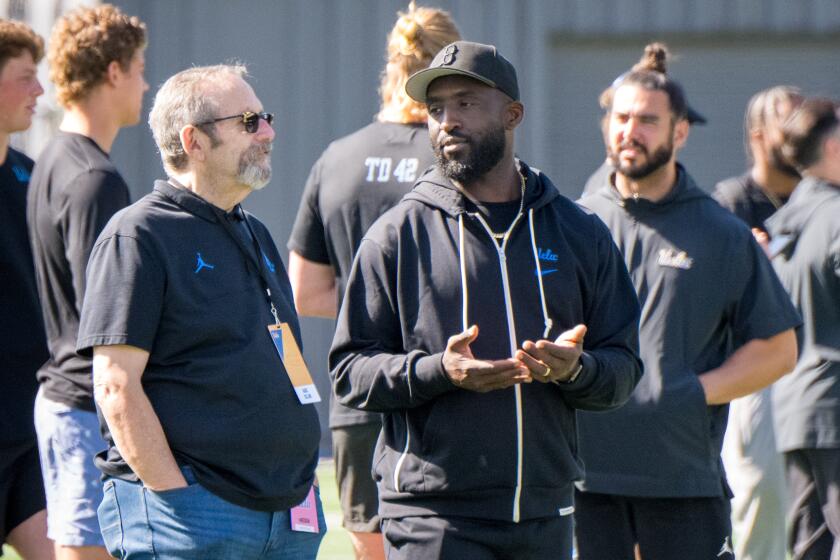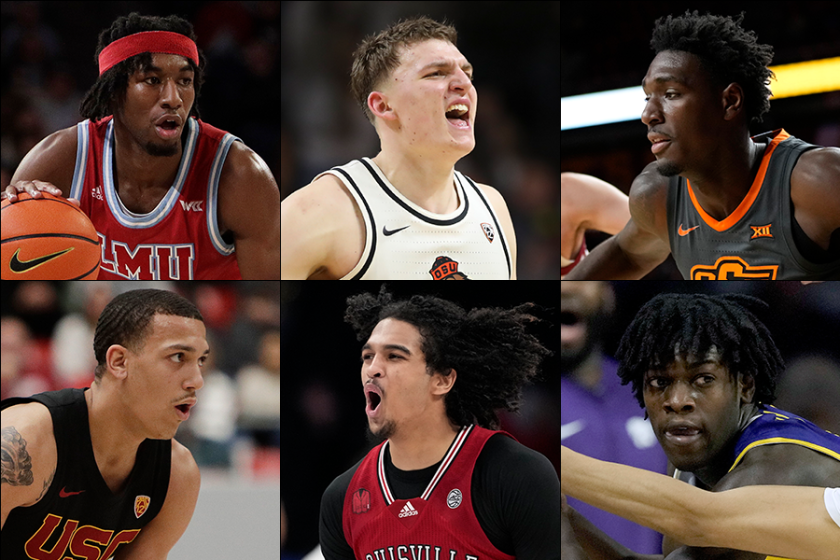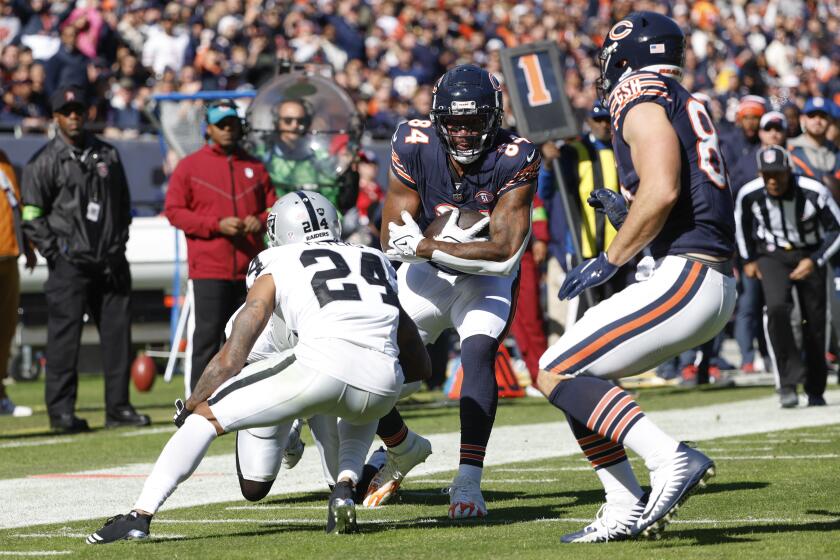Missing Memories : ’54 Bruins Might Have Been Best Ever, but They Didn’t Reach the Rose Bowl
The best football team UCLA ever had never played in a bowl game. The only undefeated, untied team in Bruin football history, coached by the shrewd, tormented, unpredictable Red Sanders, played like no team from Westwood ever has, splattering opponents to the far reaches of the Coliseum and launching memories like confetti, still falling to this day.
In 1954, UCLA went 9-0, outscored its opponents 367-40, fielded three first-team All-Americans, sent 14 players to the pros and was voted national champion by United Press International.
There were only two problems. The Associated Press picked Ohio State No. 1 and the Pacific Coast Conference kept UCLA out of the Rose Bowl. USC, which lost, 34-0, to UCLA, went instead and got drummed by Ohio State, 20-7.
Other than that, it was a banner Bruin year. A little thing called the no-repeat rule tripped up UCLA and sent the Bruins sprawling. The Pacific Coast Conference started it in 1952, basically so the conference wouldn’t have to begin each year with California getting blown out in the Rose Bowl.
The conference’s no-repeat Rose Bowl rule lasted eight years. As fate would have it, the only team affected in the rule’s short life was the 1954 UCLA Bruins.
“It was a strange deal,” said Terry Debay, 61, the Bruins’ quarterback from Canoga Park in Sanders’ single-wing formation. “But that was the way it was.”
Maybe it was strange, but it didn’t take 40 years for the Bruins of 1954 to come to terms with missing out on the Rose Bowl, probably because they feel they didn’t miss much of anything else.
It sounds almost like a cliche. They were a tight-knit bunch, all right, but they won too, all the while feeling strangely surrounded by this feeling that they were something special, something unusual, something bigger than the Coliseum.
“Oh, you’d better believe it,” said tailback Primo Villanueva, 62, the “Calexico Kid” from Mexico. “Individually, we couldn’t fight our way out of a paper bag, with some exceptions. But as a unit, there was a bond. . . . I’ve never seen anything like it before or since.”
And 40 years later, the Bruins’ best will hold a reunion Friday night at the Verdugo Club in Glendale. Many of them plan to be there, including Debay, a real estate broker in Newport Beach, and Bob Davenport, 61, the hard-running All-American fullback from Long Beach.
Davenport, who runs a bicycle touring business in Upland, Ind., is looking forward to seeing his old teammates as much as, say, the way he slammed into the line against Stanford at the Coliseum back in ’54 when UCLA won, 72-0.
“What I think about when I see the guys is that it’s probably the last time we’ll see each other this side of heaven,” Davenport said.
“All UCLA guys go to heaven, you know. There won’t be any USC guys there, though . . . and there won’t be many officials, either.”
*
In Westwood in 1954, it was a time of heaven on earth. Sanders, a brilliant tactician on the practice field and the sideline, was in his coaching prime. At 49, he was in his sixth season at UCLA after six years as coach at Vanderbilt.
Sanders assembled a notable staff in 1954 at UCLA, a group that included back coach Tommy Prothro and line coach Jim Myers. The coaching staff preached discipline, fundamentals and knocking the stuffing out of everybody who crossed their path.
Jack Tobin, a reporter who covered the 1954 Bruins for the Los Angeles Mirror, was impressed all over again every day by what Sanders had put together.
“They just dominated everybody,” Tobin said. “They blew people away.”
They did it with a stifling defense that still holds school records for fewest yards and fewest points allowed. UCLA opponents averaged 4.4 points a game in 1954 and were outscored by an average of 36.4 points a game.
Meanwhile, Sanders’ offense set a school record for points that lasted until 1973. They won by such scores as 67-0, 72-0, 61-0, 41-0 and 34-0. The only team that came close to beating UCLA was Washington, which lost, 21-20, the difference a missed extra point.
Sanders’ offensive scheme was the single wing, which resembles today’s shotgun formation. The ball usually was snapped to Villanueva, the tailback, who also called the signals. Debay was a blocking back as quarterback.
It was a simple yet effective strategy. When critics in the newspapers dubbed the UCLA attack the “horse and buggy” offense, they had to change the name after the blowouts. Soon, newspapers dubbed it the “hearse and buggy” offense, because it was killing the other teams.
“When I look back at it, it was almost a Woody Hayes mentality,” Davenport said. “You do it right, you do it consistently. It doesn’t matter how familiar defenses are with you, you could tell them where you are going because you overpower them.
“We’d stand out there for hours at practice just doing simple steps, six-inch steps, like ballet. It was a few things done so well we didn’t have to think about it.”
It wasn’t as though UCLA was starting from scratch in 1954. The Bruins were 8-2 in 1953 and got to the Rose Bowl, in which they lost to Michigan State, 28-20. When 1954 spring practice began, the Bruins started preparing for what would be their greatest season.
Sam Bogosian said that even then, the players felt it was going to be nothing less than spectacular.
Bogosian, 62, a guard from Fresno, is in the service contracting business in Los Angeles after a coaching career that included two Super Bowls as a line coach with the Raiders. There was something wonderful about the UCLA party line, right then and there, he said.
“The first day of practice, I knew we were going to be a great football team,” he said. “We all did. You could feel it in your bones, your head and your heart.”
The coaches made them feel it too. Sanders, Prothro and Myers were icons to the young players. Villanueva and Davenport said they commanded a type of respect rare in modern coach-player relations.
“They were gods,” Villanueva said. “Sanders was god and the assistant coaches were his disciples. If I saw a coach right now, I couldn’t call him by his first name if my life depended on it.”
Bogosian said he remains close to Myers, 73, who is retired after 25 years as an assistant coach with the Dallas Cowboys. Bogosian said he started calling Myers by his first name two years ago.
“It was a privilege,” Bogosian said. “I learned everything I know from Jim Myers.”
Besides all the football lessons taught him by Prothro, Davenport said he learned something else from him: fear.
“He scared the poop out of me,” Davenport said. “He was bigger than a house to us. And Jim Myers, just meaner than sin.”
Myers was baking cookies in his home in Dallas when he was asked about how mean he actually was coaching the 1954 team.
“Well, you know, you got to have a little of it,” he said.
Sanders wasn’t mean, just complicated. A scholar and a literate man, Sanders had a darker side that he battled most of his adult life.
“He was a fine coach,” said Prothro, 74, who lives in Memphis, Tenn., and is battling cancer. “I don’t know how to say this, but he was one of the finest men I have ever known when he didn’t have alcohol in him.”
Sanders, who died in 1958, was an intellectual. Tobin remembers bus rides when Sanders would look out the window and win bets from other members of the traveling party on what type of architecture they were seeing. He was also a keen judge of football talent. He found Milt Davis, who became an All-Pro defensive back, playing touch football on campus.
“He was a most amazing guy,” Myers said. “I was raised up in football under General (Bob) Neyland (at Tennessee), but the other two big influences I had were Red Sanders and Tom Landry.
“He just had great timing, good judgment and the intuition to do the right thing at the right time,” he said.
Myers said that Sam Brown, a kick return specialist and safety from McClymonds High School in Oakland, learned something first-hand about the acuity of Sanders’ timing.
“Old Sam, he always switched the ball back and forth from one hand to the other when he was running back punts,” Myers said. “Red said one day at practice ‘If you ever switch that ball again, you’re out of here.’
“Well, the next game was against Stanford and Sam ran two punts back for touchdowns, switching hands like crazy, and we win, 72-0. The next week at practice, Red never said a word.”
Brown, 61, teaches fourth and fifth grades at Grant Elementary School in Santa Monica. He does not switch hands when he writes on the chalkboard. Neither does he switch his opinion that the Bruins would have done quite well if they had been permitted to play in the 1955 Rose Bowl.
“It was such a great time if we had gone, the way our guys were hitting, we would have destroyed anybody,” he said.
*
They didn’t get the chance. The Bruins’ 34-0 victory over a USC team led by Jon Arnett and Lindon Crow, before 102,548 at the Coliseum, was UCLA’s last game of the season. It was a festive day for UCLA, beginning when a Bruin fan in a Trojan uniform rode into the Coliseum on a mule waving a toy sword.
Most USC observers found nothing about the game even remotely amusing. It was the second-worst defeat in USC history, a fact that did not escape Trojan Coach Jess Hill.
“They’re No. 1 in the nation as far as I’m concerned,” Hill said afterward.
In the UPI coaches’ poll, UCLA was No. 1 with 328 points and Ohio State was No. 2 with 321 points. The AP writers’ poll had 9-0 Ohio State No. 1 with 3,670 points and UCLA No. 2 with 3,594 votes.
The Bruins were not allowed to try to make up the 74-point difference.
“We knew the rules,” Prothro said. “I don’t think it upset us a whole lot. Now that I look back on it, I know what kind of team we had. Relative to its time, I think it’s the best college team I’ve ever seen.”
Villanueva, who lives in Vancouver and owns a business that produces chips and salsa, said there’s no doubt in his mind that the team he played for was the best in the nation. And, like Bogosian, he had to accept the effect of the rule.
“It was a matter of life, it was a matter of fact,” Bogosian said. “It just wasn’t meant to be.”
The team said goodby to the 1954 season at the awards banquet, held Dec. 9 in the Crystal Room of the Beverly Hills Hotel. Phil Harris was the toastmaster.
They say hello again to each other Friday night. John Peterson, 61, captain of the 1954 team, put together the reunion. He was from University High and played center and linebacker.
Peterson, who owns two car dealerships in Los Angeles, said what was lost still drives him.
“We always felt we were the best team, but we never had the opportunity to prove it,” he said.
This sense of loss may be a topic of discussion at the reunion. Then again, maybe not. Jack Ellena, 63, an All-American tackle from Susanville, Calif., only wants to see his old friends again. He said it’s going to be a special time, all right.
“I’m sure we’ll take up right where we left off,” he said. “When we’re together, time stands still.”
Go beyond the scoreboard
Get the latest on L.A.'s teams in the daily Sports Report newsletter.
You may occasionally receive promotional content from the Los Angeles Times.



